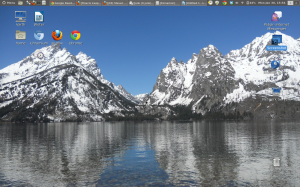Mint's Cinnamon: The Future of the Linux Desktop? (Review)

Over the last few years, we've seen radical changes to the Linux desktop. Some, despite initial opposition, such as the KDE 4.x re-start, took a while to gain favor, but eventually became popular. Others, such as GNOME 3.x have alienated many users and first Ubuntu's Unity and now it's Head-Up Display (HUD) have not been greeted with overwhelming approval even by hard-core Ubuntu Linux users. So, Linux Mint's developers have decided to go back to the past with a GNOME 2.x style desktop: Cinnamon. So, how well have they done? I give them an "A" for effort, but only a "B" for execution.
To put Cinnamon to the test, I used my faithful old Lenovo ThinkPad R61. This 2008-vintage notebook is powered by a 2.2GHz Intel Core 2 Duo processor T7500 and has 2GBs of RAM. I also used it on my Dell Inspiron 530S powered by a 2.2-GHz Intel Pentium E2200 dual-core processor with an 800-MHz front-side bus. This PC has 4GBs of RAM, a 500GB SATA (Serial ATA) drive, and an Integrated Intel 3100 GMA (Graphics Media Accelerator) chip set.
For the operating system, although Cinnamon will run on Ubuntu 11.10, Fedora 16, OpenSUSE 12.1, Arch Linux, and Gentoo, I elected to run it on its "native" Linux Mint 12. Cinnamon runs on top of GNOME 3.2, but its look and feel comes from GNOME 2.x.
A walk through Mint Linux's new/old Cinnamon desktop (Gallery)
As Clement Lefebvre, Linux Mint's lead developer said when he introduced Cinnamon, "I'm not going to argue whether Gnome Shell is a good or a bad desktop. It's just not what we're looking for. GNOME 3.x certainly wasn't the desktop I wanted either so I was very interested in seeing what Mint's programmers would come up with since I've long liked their design work.
My first impression of Cinnamon on both computers was great. It felt just as if I were back using GNOME 2.x. It was really nice to have my good-old GNOME menu back again, and better still that when I was done with a session, I could easily shut it down, suspend, or restart my desktop without the keyboard shenanigans that GNOME 3.x requires.
Cinnamon also has some nice extras added in. For example, I can automatically search in the menu, ala GNOME 3.x, by sub-string when I can't recall exactly where a program is hiding in the menu. A related change is that, unlike GNOME 3.x in this case, when you open a new window it gets the focused by default--instead of, as Lefebvre puts it so well, "appearing in the back with an annoying 'Your window is ready' notification."
You can also once more change your desktop's layout. I, for instance, really like having the menubar at the top of the display instead of at the bottom and Cinnamon lets me set it up that away again. I could also set it with panels at both the top and bottom of the display. There is one small gotcha though: To change the layout you have to set it and then restart Cinnamon.
Cinnamon also has a new configuration tool called "Cinnamon Settings." With it you can switch themes, apply desktop effects, add applets and extensions to your desktop and configure some of the settings of the desktop. You cannot, however, use Gnome 3.x Shell themes in Cinnamon.
Themes are also a little hard to manage in this first "shipping" version of Cinnamon. You still have to go hither and yon to manage them. The theme control problem, fortunately, is already being addressed.
The applets are what I found most interesting. There are optional desktop mini-programs. They are installed by default, but you decide if you want to use them or not. These include an excellent set of accessibility tools; the power to set up a Recent Documents icon on the system tray itself; control over your removable drives and trash; and some basic display tools. I'm already using the Recent Documents control all the time.
That's the good news. Now, here's why I can't get Cinnamon an "A" yet. First, the new animation settings felt really jerky to me. Now, I'm not running Mint 12 on very fast machines, but they're not slow either and I found the Windows effect, even after tuning them, to be just to annoying to be useful.
There are also some bugs in the Cinnamon. For example, the Pidgin, my favorite IM client, icon disappears from time to time. A more noticeable example is that I couldn't add some applications to "Favorites" from within the menu or by using the dconf-editor. Curiously, I could add them to the Desktop or Panel. This is a known problem, and it's already been fixed in the source code. I also see display quirks such as oddly overlapping windows from time to time.
What concerned me the most though is that some applications, the Evolution e-mail client and LibreOffice would sometime freeze up under Cinnamon. I can forgive a lot, but having my e-mail and word processor lock up on me is close to unforgivable. It doesn't happen very often at all, but even once a day or so is really vexing.
Still, these are very early days for Cinnamon, so I'm willing to give this desktop a good solid "B." If Mint continues to improve Cinnamon at the rate it's been going at though it won't be long before Cinnamon will have earned not just an "A" but an "A+" for all GNOME Linux desktop users.
Want to see if you think Cinnamon gets a passing grade? You can download Cinnamon from Mint today.
Related Stories:
Linux Mint releases Cinnamon, GNOME 2.x style desktop
Linux Mint's Cinnamon: A GNOME 3.x shell fork
Linux users cautiously optimistic about Ubuntu's Head-Up Display desktop
